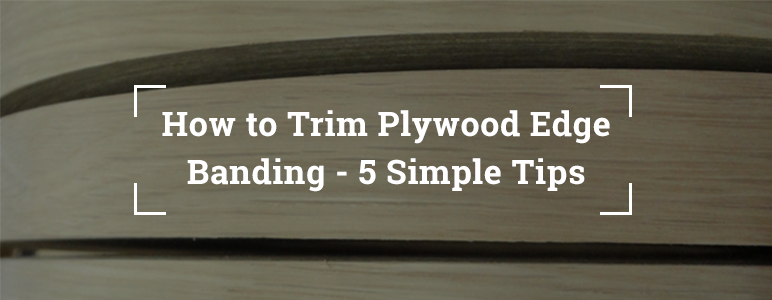Plywood Edgebanding
5 Simple Tips to Trim Plywood Edge Banding
Plywood edge banding is the process of applying a similar product to the edges as is on the flat panel part of the plywood product. Plywood is a loosely used term that can be veneer core plywood, which is made of plies of wood or MDF or IPB which are medium density fibre board and industrial particle board.
In the case of using a wood veneer for edging these products, it is best to use a preglued wood veneer edgebanding with hot melt adhesive that can be ironed on and trimmed.
5 Effortless Tricks to Trim Plywood Edge Banding
The following are some of the best and simple ways to do edge banding:
Clean the edges.
Smoothen the piece of wood using sandpaper by hand or with a sander to get rid of the rough surface. Getting the edges to be high density as possible with fewest voids is the goal here.
Wipe off any remaining dust with denatured alcohol for the best results, although hot melt adhesive will still work well with some remaining residue.
Iron them well.
Ironing with a household iron is the most common method of using plywood edge banding. Ensure that the iron is dry, as moisture may cause warping of the wood veneer edgebanding. Cut an inch or so oversize on each end and align the wood veneer against the edge of the panel loosely.
Move the iron back and forth with your hand placed on the edge of the wood. This prevents the wood from sliding away. Iron the wood for a couple of seconds. Be careful as the product will be very hot and make sure the iron doesn’t remain on the wood veneer so long as to burn it and leave black marks, though they would still sand off.
Start while the wood is hot.
Make sure that you complete the plywood edge banding under uniform temperature and pressure. Ensure that there are no bumpy areas on the wood. If there are, then heat the iron again and press those sides to prevent from ruining the end result.
Ideally, press each side for about 20 seconds and wait for another 10 seconds to let it cool. This helps the wood to stay perfectly aligned with the edge. Once cooled, the next step is trimming.
Final Steps of Plywood Edge Banding
Follow these steps of plywood edge banding to add perfection to the process.
Trim down the edges
Plywood edge banding is now ready for trimming and sanding.
The wood veneer edgbanding can be trimmed with a variety of methods. It can be sanded off, an edgebanding trimmer (available from JSO Wood Products) can be used, a chisel or razor knife, or a router.
Maintain an angle that will result in the desired finish edge and do not over-trim but rather under trim and use the next process of sanding to perfection.
Sanding the edge
The final step in edge banding is to give the plywood a finishing touch. Use sandpaper to polish the edges slightly. Once you do this, move your hand on the surface and check for any irregularities. Sanding at an angle will meld the edge close to the flat plywood panel and round it off well.
The final step is finishing, which should be done with the same product as is used on the flat panel. Edges tend to take a fair amount of abuse and should be well protected with a thick coating.
These are some of the most professional tips to deal with plywood edge banding with expertise. Always take care to spend sufficient time on each step to make the process smooth and effective.
If you have questions about edgebanding with wood, PVC, polyester, melamine or any other product, please contact the professionals at JSO Wood Products. Experienced since 1995.
